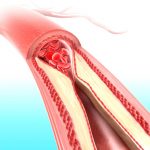 Women with ST segment elevation myocardial infarction (STEMI) heart attack face higher mortality risk in hospitals than men.
Women with ST segment elevation myocardial infarction (STEMI) heart attack face higher mortality risk in hospitals than men.
A STEMI heart attack is when the coronary artery is completely blocked off due to a blood clot, thus stopping blood flow to the affected part of the heart so it begins to die.
Advertisement
A STEMI heart attack is determined by an electrocardiogram (ECG) test. Changes in an ECG test can determine the severity and type of heart attack a person is having.
For a STEMI heart attack, the changes involve an elevation known as an ST segment. This elevation indicates large amounts of heart muscle damage and that is what contributes to the heart attack’s name – STEMI.
Women with STEMI heart attack are more likely to die in hospital than men
 Researchers have found that women were less likely to receive life-saving angioplasty and stenting to restore blood flow from a STEMI heart attack compared to men. Women were also more likely to stay in hospitals for longer and have higher mortality rates in hospitals. The findings were published in the Journal of the American College of Cardiology.
Researchers have found that women were less likely to receive life-saving angioplasty and stenting to restore blood flow from a STEMI heart attack compared to men. Women were also more likely to stay in hospitals for longer and have higher mortality rates in hospitals. The findings were published in the Journal of the American College of Cardiology.
STEMI is the most deadly form of heart attack but recovery is possible with stenting and restoration of blood flow. Rates of heart attack in patients under 60 have not changed, but trends have begun emerging that reveal treatment in younger patients.
Researchers examined data from 632,930 STEMI heart attack patients between the ages of 18 and 59. Women were less likely to present STEMI and receive treatment to restore blood flow compared to men. What was shown was that procedures of stenting did increase in both men and women.
Death rates of women with STEMI heart attack were also higher; 4.5 percent of women died in the hospital compared to three percent of men. Women also had longer hospital stays – an average of 4.35 days, versus four days for men. Researchers explained that men have a higher likelihood to die prior to reaching the hospital, which could explain the in-hospital mortality differences.
Researchers suggest that women are less likely to receive revascularization because they frequently do not experience chest pain, which could delay treatment. Furthermore, women are at a higher risk of bleeding in procedures to restore blood flow compared to men.
Senior author of the study, Deepak L. Bhatt, M.D., said, “Despite guidelines directing use of stenting in heart attack patients, younger women are receiving this life-saving treatment method less than younger men. Our research shows that there is a great opportunity and need to improve national heart attack care processes and outcomes and address these sex disparities in providing care to younger heart attack patients.”
Common symptoms of STEMI
 Common symptoms of STEMI include:
Common symptoms of STEMI include:
- Chest pain
- Heartburn
- Excessive sweating
- Weakness
- Light-headedness
- Nausea
- Vomiting
- Heart palpitations
- Shortness of breath
- Loss of consciousness
In women symptoms of STEMI may differ slightly. Symptoms common for STEMI in women are:
- Shortness of breath
- Weakness
- Fatigue
- Loss of sensation in fingertips
- Abdominal pain
Risk factors that can contribute to a STEMI heart attack are:
- High cholesterol
- High blood pressure
- Genetic pre-disposition
- Poor lifestyle choices
- Being between the ages of 40 and 55
 Differences between STEMI and NSTEMI heart attack
Differences between STEMI and NSTEMI heart attack
NSTEMI (non-ST segment elevation myocardial infarction) and STEMI are two known types of heart attack. STEMI heart attacks account for 70 percent of experienced heart attacks and NSTEMI accounts for 30 percent. Although the names may be similar, the two types of heart attack have their own unique differences.
NSTEMI heart attacks occur due to the complete blockage or closure of a minor coronary artery, or partial blockage or closure of a major artery that was previously affected by atherosclerosis. STEMI, on the other hand, is the complete blockage of a major artery, which can have been affected by atherosclerosis.
Both NSTEMI and STEMI heart attacks produce the same symptoms. But when both types of heart attack are being viewed with an ECG test, NSTEMI will not show an elevation as it would with a STEMI heart attack.
Lastly, although complications can occur in both NSTEMI and STEMI heart attacks, complications like cardiogenic shock, left ventricular failure, severe mitral regurgitation due to papillary muscle rupture and cardiac tamponade due to ventricular wall rupture are far more common in STEMI heart attacks.
Treatment and management for STEMI heart attacks
Advertisement
Initial treatment for a STEMI heart attack is to fix the underlying cause of it. In the majority of cases, STEMI heart attack is due to a complete blockage of an artery, so being able to unblock the artery and restore blood flow is the first course of treatment.
An artery can be unblocked in two ways: Medication or angioplasty. Medication is administered in a hospital but its success rate is only 60 to 80 percent. There is also a higher risk of serious bleeding when it comes to medications that unblock an artery.
Angioplasty, on the other hand, where a small balloon is inserted into the body and inflated to mechanically open the artery, has more success. The success rate with angioplasty is 90 percent but can only be performed at specialized centers.
